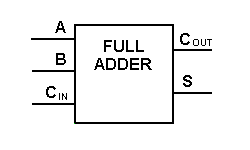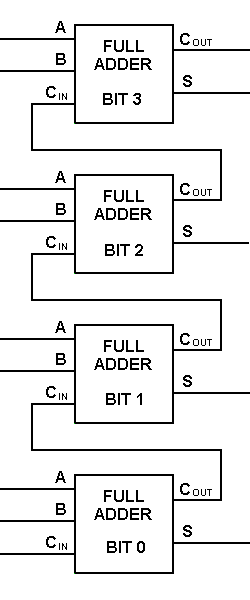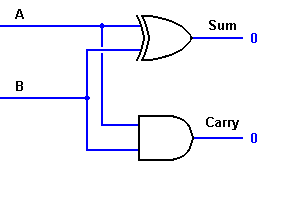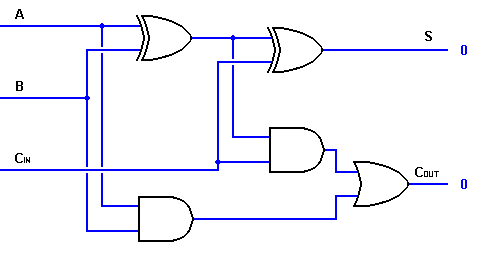Adding Binary Numbers

Direct links to other logic pages:
Combinational Logic:
[Basic Gates]
[Derived Gates]
[The XOR Function]
[Binary Addition]
[Multiplexer]
[Decoder/Demultiplexer]
Sequential Logic:
[RS NAND Latch]
[Clocked RS Latch]
[RS Flip-Flop]
[JK Flip-Flop]
[D Latch]
[Flip-Flop Symbols]
Counters:
[Basic 4-Bit Counter]
Registers:
(Coming Soon)
Return to Digital index page.
Return to Play-Hookey Home Page.

A key requirement of digital computers is the ability to use logical
functions to perform arithmetic operations. The basis of this is addition;
if we can add two binary numbers, we can just as easily subtract them, or
get a little fancier and perform multiplication and division. How, then,
do we add two binary numbers?
Let's start by adding two binary bits. Since each bit has only two
possible values, 0 or 1, there are only four possible combinations of
inputs. These four possibilities, and the resulting sums, are:
0 + 0 = 0
0 + 1 = 1
1 + 0 = 1
1 + 1 = 10
Whoops! That fourth line indicates that we have to account for two
output bits when we add two input bits: the sum and a possible carry.
Let's set this up as a truth table with two inputs and two outputs, and
see where we can go from there.
| INPUTS |
OUTPUTS |
Well, this looks familiar, doesn't it? The Carry output is a simple AND
function, and the Sum is an Exclusive-OR. Thus, we can use two gates to
add these two bits together. The resulting circuit is shown below.
|
| A |
B |
CARRY |
SUM |
| 0 |
0 |
0 |
0 |
| 0 |
1 |
0 |
1 |
| 1 |
0 |
0 |
1 |
| 1 |
1 |
1 |
0 |

|
To construct a full adder circuit, we'll need three inputs and two
outputs. Since we'll have both an input carry and an output carry, we'll
designate them as CIN and COUT. At the same time,
we'll use S to designate the final Sum output. The resulting truth table
is shown to the right.
Hmmm. This is looking a bit messy. It looks as if COUT may
be either an AND or an OR function, depending on the value of A, and S is
either an XOR or an XNOR, again depending on the value of A. Looking a
little more closely, however, we can note that the S output is actually an
XOR between the A input and the half-adder SUM output with B and
CIN inputs. Also, the output carry will be true if any two or
all three inputs are logic 1.
What this suggests is also intuitively logical: we can use two
half-adder circuits. The first will add A and B to produce a partial Sum,
while the second will add CIN to that Sum to produce the final
S output. If either half-adder produces a carry, there will be an output
carry. Thus, COUT will be an OR function of the half-adder
Carry outputs. The resulting full adder circuit is shown below.
|
INPUTS |
OUTPUTS |
| A |
B |
CIN |
COUT |
S |
| 0 |
0 |
0 |
0 |
0 |
| 0 |
0 |
1 |
0 |
1 |
| 0 |
1 |
0 |
0 |
1 |
| 0 |
1 |
1 |
1 |
0 |
| 1 |
0 |
0 |
0 |
1 |
| 1 |
0 |
1 |
1 |
0 |
| 1 |
1 |
0 |
1 |
0 |
| 1 |
1 |
1 |
1 |
1 |


The circuit above is really too complicated to be used in larger logic
diagrams, so a separate symbol, shown to the right, is used to represent a
one-bit full adder. In fact, it is common practice in logic diagrams to
represent any complex function as a "black box" with input and
output signals designated. It is, after all, the logical function that is
important, not the exact method of performing that function.


Now we can add two binary bits together, accounting for a possible
carry from the next lower order of magnitude, and sending a carry to the
next higher order of magnitude. To perform multibit addition the way a
computer would, a full adder must be allocated for each bit to be added
simultaneously. Thus, to add two 4-bit numbers to produce a 4-bit sum
(with a possible carry), you would need four full adders with carry lines
cascaded, as shown to the left. For two 8-bit numbers, you would need
eight full adders, which can be formed by cascading two of these 4-bit
blocks. By extension, two binary numbers of any size may be added in this
manner.
It is also quite possible to use this circuit for binary subtraction.
If a negative number is applied to the B inputs, the resulting sum
will actually be the difference between the two numbers. In a modern
computer, the adder circuitry will include the means of negating one of
the input numbers directly, so the circuit can perform either addition or
subtraction on demand. Other functions are commonly included in modern
implementations of the adder circuit, especially in modern
microprocessors.
 Back to the Play-Hookey main page.
Back to the Play-Hookey main page.



